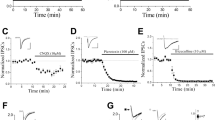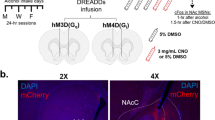Abstract
The medium spiny neurons of the nucleus accumbens receive both an excitatory glutamatergic input from forebrain and a dopaminergic input from the ventral tegmental area. This integration point may constitute a locus whereby the N-methyl-D-aspartate (NMDA)-subtype of glutamate receptors promotes drug reinforcement. Here we investigate how dopaminergic inputs alter the ethanol sensitivity of NMDA receptors in rats and mice and report that previous dopamine receptor-1 (D1) activation, culminating in dopamine and cAMP-regulated phosphoprotein-32 kD (DARPP-32) and NMDA receptor subunit-1 (NR1)-NMDA receptor phosphorylation, strongly decreases ethanol inhibition of NMDA responses. The regulation of ethanol sensitivity of NMDA receptors by D1 receptors was absent in DARPP-32 knockout mice. We propose that DARPP-32 mediated blunting of the response to ethanol subsequent to activation of ventral tegmental area dopaminergic neurons initiates molecular alterations that influence synaptic plasticity in this circuit, thereby promoting the development of ethanol reinforcement.
This is a preview of subscription content, access via your institution
Access options
Subscribe to this journal
Receive 12 print issues and online access
$209.00 per year
only $17.42 per issue
Buy this article
- Purchase on Springer Link
- Instant access to full article PDF
Prices may be subject to local taxes which are calculated during checkout





Similar content being viewed by others
References
Wise, R.A. Drug-activation of brain reward pathways. Drug Alcohol Depend. 51, 13–22 (1998).
Ungless, M.A., Whistler, J.L., Malenka, R.C. & Bonci, A. Single cocaine exposure in vivo induces long-term potentiation in dopamine neurons. Nature 411, 587–587 (2001).
Vorel, S.R., Liu, X., Hayes, R.J., Spector, J.A. & Gardner, E.L. Relapse to cocaine-seeking after hippocampal theta burst stimulation. Science 292, 1175–1178 (2001).
Nestler, E.J., Neurobiology. Total recall-the memory of addiction. Science 292, 2266–2267 (2001).
Woodward, J.J. Ethanol and NMDA receptor signalling. Crit. Rev. Neurobiol. 14, 68–89 (2000).
Lovinger, D.M., White, G. & Weight, F.F. Ethanol inhibits NMDA-activated ion currents in hippocampal neurons. Science 243, 1721–1724 (1989).
Hoffman, P.L., Rabe, C.S., Moses, F. & Tabakoff, B. N-methyl-D-aspartate receptors and ethanol: inhibition of calcium flux and cyclic GMP production. J. Neurochem. 52, 1937–1940 (1989).
Morrisett, R.A. & Swartzwelder, H.S. Attenuation of hippocampal long-term potentiation by ethanol: a patch clamp analysis of glutamatergic and GABAergic mechanisms. J. Neurosci. 13, 2264–2272 (1993).
Thomas, M.P., Monaghan, D.T. & Morrisett, R.A. Evidence for a causative role of NMDA receptors in an in vitro model of alcohol withdrawal hyperexcitability. J. Pharmacol. Exp. Therap. 287, 87–97 (1998).
Thomas, M.P. & Morrisett, R.A. Dynamics of NMDAR-mediated neurotoxicity during chronic ethanol exposure and withdrawal. Neuropharmacology 39, 218–226 (2000).
Grant, K.A., Knisely, J.S., Tabakoff, B., Barrett, J.E. & Balster, R.L. Ethanol-like discriminative stimulus effects on non-competitive N-methyl-D-aspartate antagonists. Behav. Pharmacol. 2, 87–95 (1991).
Risinger, F.O., Freeman, P.A., Greengard, P. & Fienberg, A.A. Motivational effects of ethanol in DARPP-32 knock-out mice. J. Neurosci. 21, 340–348 (2001).
Fienberg, A.A. et al. DARPP-32: regulator of the efficacy of dopaminergic neurotransmission. Science 281, 838–842 (1998).
Hemmings, J.H.C., Greengard, P., Tung, H.Y.L. & Cohen, P. DARPP-32, a dopamine-regulated neuronal phosphoprotein, is a potent inhibitor of protein phosphatase-1. Nature 310, 503–505 (1984).
Snyder, G.L., Fienberg, A.A., Huganier, R.L. & Greengard, P.A. A dopamine/D1 receptor/protein kinase A/dopamine- and cAMP-regulated phosphoprotein (Mr 32 kDa)/protein phosphatase-1 pathway regulated dephosphorylation of the NMDA receptor. J. Neurosci. 18, 10297–10303 (1998).
Fedorov, N.B. & Reymann, K.G. Simultaneous local pressure microejection of excitatory amino acids and field potential recording with single micropipette in the hippocampal slice. J. Neurosci. Meth. 50, 83–90 (1993).
El-Ghundi, M. et al. Disruption of dopamine D1 receptor gene expression attenuates alcohol-seeking behavior. Eur. J. Pharmacol. 353, 149–158 (1998).
Gonzales, R.A. & Weiss, F. Suppression of ethanol-reinforced behavior by naltrexone is associated with attenuation of the ethanol-induced increase in dialysate dopamine levels in the nucleus accumbens. J. Neurosci. 18, 10663–10671 (1998).
Brodie, M.S., Pesold, C. & Appel, S.B. Ethanol directly excites dopaminergic ventral tegmental reward neurons. Alcohol. Clin. Exp. Res. 23, 1848–1852 (1999).
Biala, G. & Kotlinska, J. Blockade of the acquisition of ethanol-induced conditioned place preference by N-methyl-D-asparate receptor antagonists. Alcohol Alcohol 34, 175–182 (1999).
Pennartz, C., Aneerun, R., Groenewegen, H. & Lopes da Silva, F . Synaptic plasticity in an in vitro slice preparation of the rat nucleus accumbens. Eur. J. Neurosci. 5, 107–117 (1993).
Kombian, S.B. & Malenka, R.C. Simultaneous LTP of non-NMDA- and LTD of NMDA-receptor-mediated responses in the nucleus accumbens. Nature 368, 242–246 (1994).
Thomas, M.J., Malenka, R.C. & Bonci, A. Modulation of long-term depression by dopamine in the mesolimbic system. J. Neurosci. 20, 5581–5586 (2000).
Kalluri, H. & Ticku, M. Effect of ethanol on phosphorylation of the NMDAR2B subunit in mouse cortical neurons. Brain Res. Mol. Brain Res. 68, 159–168 (1999).
Anders, D., Blevins, T., Smothers, C. & Woodward, J.J. Reduced ethanol inhibition of N-methyl-D-aspartate receptors by deletion of the NR1 C0 domain or overexpression of α-actinin-2 proteins. J Biol. Chem. 275, 15019–15024 (2000).
Rajadhyalsha, A. et al. L-type Ca2+ channels are essential for glutamate-mediated CREB phosphorylation and c-fos gene expression in striatal neurons. J. Neurosci. 19, 6348–6359 (1999).
Halpain, S., Girault, J.-A. & Greengard, P. Activation of NMDA receptors induces dephosphorylation of DARPP-32 in rat striatal slices. Nature 343, 369–372 (1990).
Givens, B., Williams, J. & Gill, T. Septohippocampal pathway as a site for the memory-impairing effects of ethanol. Hippocampus 10, 111–121 (2000).
Snyder, G.L. et al. Phosphorylation of DARPP-32 and protein phosphatase inhibitor-1 in rat choroid plexus: regulation by factors other than dopamine. J. Neurosci. 12, 3071–3083 (1992).
Hemmings, J.H.C. & Greengard, P. DARPP-32, a dopamine-and adenosine 3′:5′-monophosphate-regulated phosphoprotein: regional, tissue, and phylogenetic distribution. J. Neurosci. 6, 1469–1481 (1986).
Acknowledgements
This work was supported primarily by NIH R01AA11845 (R.A.M.) and the Integrative Neuroscience Initiative on Alcoholism (INIA, NIH U01AA13CR (R.E.M.)), the Texas Commission on Alcoholism and Drug Abuse (TCADA) and the Waggoner Center on Alcoholism and Addiction Research (WCAAR) (R.A.M.). Additional support was from NIH R01AA11852 (R.A.G.) and R01AA11836 (S.W.L.) and T32AA07471 (K.F-K.). The authors thank R.A. Harris and A. Hendricson for suggestions and discussion, P. Greengard and P. Ingrassia for DARPP-32 antibodies and DARPP-32 modified mice, and A. Miao and M. Jia for technical support.
Author information
Authors and Affiliations
Corresponding author
Ethics declarations
Competing interests
The authors declare no competing financial interests.
Rights and permissions
About this article
Cite this article
Maldve, R., Zhang, T., Ferrani-Kile, K. et al. DARPP-32 and regulation of the ethanol sensitivity of NMDA receptors in the nucleus accumbens. Nat Neurosci 5, 641–648 (2002). https://doi.org/10.1038/nn877
Received:
Accepted:
Published:
Issue Date:
DOI: https://doi.org/10.1038/nn877
This article is cited by
-
Dissecting Brain Networks Underlying Alcohol Binge Drinking Using a Systems Genomics Approach
Molecular Neurobiology (2019)
-
Psychopharmacology of Tobacco and Alcohol Comorbidity: a Review of Current Evidence
Current Addiction Reports (2017)
-
Dual regulation by ethanol of the inhibitory effects of ketamine on spinal NMDA-induced pressor responses in rats
Journal of Biomedical Science (2012)
-
Inhibition of the Casein-Kinase-1-Epsilon/Delta Prevents Relapse-Like Alcohol Drinking
Neuropsychopharmacology (2012)
-
Association Between DARPP-32 Gene Polymorphism and Personality Traits in Healthy Chinese-Han Subjects
Journal of Molecular Neuroscience (2011)



